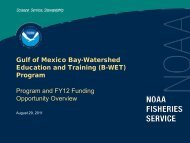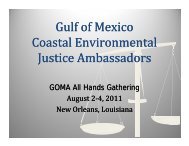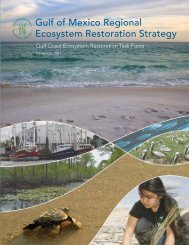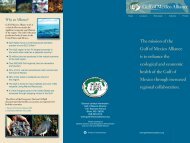Mexican Monitoring Response to Deepwater Horizon
Mexican Monitoring Response to Deepwater Horizon
Mexican Monitoring Response to Deepwater Horizon
You also want an ePaper? Increase the reach of your titles
YUMPU automatically turns print PDFs into web optimized ePapers that Google loves.
<strong>Moni<strong>to</strong>ring</strong> and Assessing Potential<br />
Impacts of the <strong>Deepwater</strong> Oil Spill<br />
National Institute of Ecology (INE- INECC)<br />
Margarita Caso
1. Background<br />
• April 2010, oil spill begins<br />
with the collapse of the<br />
<strong>Deepwater</strong> <strong>Horizon</strong><br />
platform, owned by<br />
British Petroleum and its<br />
partners.<br />
• The Macondo well<br />
(depth of 1,525 m) -<br />
finally sealed on August<br />
2010.
Largest oil spill in his<strong>to</strong>ry: 4.9 million barrels spilled<br />
<strong>Deepwater</strong> <strong>Horizon</strong> (Abr 2010 - EUA)<br />
Ix<strong>to</strong>c I (Jun 1979 - México)<br />
Oil Well (Mar 1990 -Uzbekistan)<br />
Kharyaga-Usinsk Pipeline (Oct 1994 - Rusia)<br />
Castillo de Beliver (Ago 1993 - Sudáfrica)<br />
Amoco Cadiz (Mar 1978 - Francia<br />
Odyssey (Nov 1988 - Canada)<br />
D-103 consession well (Ago 1980 - Libia)<br />
Haven (Abr 1991 - Italia)<br />
HISTORIC MAJOR WORLD<br />
OIL SPILLS<br />
(Millions barrels)<br />
Atlantic Empress (1) (Jul 1979 - Trinidad y …<br />
0 1 2 3 4 5<br />
Unprecedented amount of dispersants used: ≈ 6.9 million L, 42% directly in<br />
the well. Effects are yet unknown.<br />
Source:The Economist ,2010.
2. Action Plan – May 2010<br />
The action plan produced by the <strong>Mexican</strong> Government<br />
consists of the following sections:<br />
a) Objective<br />
b) Scope<br />
c) Overall coordination and organization<br />
d) Public information<br />
e) Action lines:<br />
- <strong>Moni<strong>to</strong>ring</strong> - Establishment of a moni<strong>to</strong>ring group -<br />
headed by INE<br />
- Training and Education<br />
- Hazard mitigation actions<br />
f) Procedures<br />
g) Financing
<strong>Moni<strong>to</strong>ring</strong> Group headed by INE – June 2010<br />
Coordination and Strategy<br />
Several academic and government institutions were<br />
gathered for the design of the moni<strong>to</strong>ring strategy<br />
a) The establishment of a baseline in the <strong>Mexican</strong> portion of<br />
the Gulf<br />
b) Long-term moni<strong>to</strong>ring<br />
Large-scale long-term effects both, spatial and temporal.
INE - Coordination of the moni<strong>to</strong>ring effortthe<br />
establishemt of the baseline<br />
1. Identification of the<br />
minimum necessary studies <strong>to</strong><br />
establish the baseline<br />
2. Identification of vulnerable<br />
regions<br />
3. Harmonization and<br />
standardization of<br />
methodology (parameter<br />
definition )<br />
4. Division of the study area<br />
between the academic and<br />
government institutions<br />
• Loop Current<br />
• Anticyclonic eddies
2. Identification of the minimum necessary studies<br />
<strong>to</strong> establish the baseline<br />
The baseline for the <strong>Mexican</strong> portion of the Gulf should at<br />
least consider:<br />
1. Hydrological characterization<br />
2. Current levels of hydrocarbons and metals in the water<br />
column, sediment and biota<br />
3. Characterization studies of coastal ecosystems - seagrass<br />
beds as sentinel ecosystems of environmental change<br />
4. Studies in sea turtles as examples of migra<strong>to</strong>ry species<br />
5. Eco<strong>to</strong>xicological studies in tissues of fish and turtle eggs<br />
6. Model of the dispersion of the oil weathered phases
3. Identification of potential impacts-<br />
Hydrological characterization<br />
TAMAULIPAS AND VERACRUZ<br />
UNAM – Dr. Luis So<strong>to</strong><br />
2010 - June - July<br />
2011 - January – February<br />
2012- Oc<strong>to</strong>ber-November<br />
B/O Jus<strong>to</strong> Sierra -<br />
UNAM<br />
Collaboration IMP<br />
YUCATAN<br />
CINVESTAV – Dr. Gerardo Gold<br />
2010 - September<br />
2011 - January – February<br />
2012- November- December<br />
DEEP SEA<br />
CICESE- Dr. Juan Carlos Herguera<br />
2010 - Oc<strong>to</strong>ber– November<br />
2011 – July<br />
2012 - Oc<strong>to</strong>ber
Latitud N<br />
Ni<br />
26.0<br />
1 2 34 5<br />
Río Bravo<br />
µ<br />
-1<br />
gg<br />
24.0<br />
21 223 24 25 10 9 8 7<br />
6<br />
25.0 Laguna<br />
11 12 13 14 15<br />
Madre<br />
20 19 1817 16<br />
23.0<br />
Río So<strong>to</strong><br />
La Marina<br />
50.79<br />
41.78<br />
35.35<br />
28.92<br />
22.49<br />
16.06<br />
22.0<br />
Río<br />
Pánuco<br />
9.63<br />
Laguna<br />
Tamiahua<br />
98.0 97.0 96.0<br />
Longitud O
Species sampling - baseline<br />
Sea turtle eggs analysis as examples of<br />
migra<strong>to</strong>ry species that connect the<br />
ecosystem.<br />
- Kemp’s ridley turtle (Lepidochelys kempii)<br />
–Loggerhead turtle (Caretta caretta)-<br />
–Green turtle (Chelonia mydas) –<br />
–Hawksbill turtle (Eretmochelys imbricata)<br />
Collaboration CONANP<br />
Eco<strong>to</strong>xicology analysis -<br />
baseline<br />
1. Evaluation of <strong>to</strong>xicity- water and<br />
sediment samples using Micro<strong>to</strong>x<br />
test (Vibrio fischeri)<br />
2. Evaluation of biomarkers in<br />
mollusks<br />
Collaboration – UAM- Dr. Patricia Ramírez<br />
1<br />
2<br />
6<br />
5<br />
8<br />
3<br />
4<br />
7<br />
Guzmán-Martínez
Ecosystem characterization (seagrasses- baseline)<br />
• Seagrass beds are an important<br />
component of coastal wetlands<br />
Global coverage ≈ 0.1-0.2% of the coastal<br />
ocean<br />
Highly productive communities<br />
• Important spawning, nesting, shelter,<br />
protection, and feeding areas (turtles,<br />
manatees, fish, shrimp, seahorses,<br />
oc<strong>to</strong>pus, sea cucumbers).<br />
• Excellent protection of coastal areas<br />
• "Environmental sentinels"<br />
In collaboration with the Metropolitan<br />
University - (Dr. Margarita Gallegos)
A Hydroacoustic Biosonic echosounder was used, <strong>to</strong> produce maps of seagrass<br />
distribution, and <strong>to</strong> get their coverage, density, height and depth. Water and sediment<br />
sampling was performed for the determination of all biotic and abiotic parameters.<br />
The areas studied are shown in the following table.<br />
The area covered by<br />
seagrasses is reported for<br />
the first time in the<br />
<strong>Mexican</strong> part of the Gulf of<br />
Mexico. 1,055,338 km2
Dispersion of weathered oil phases<br />
Reconstruction of the concentration of oil from the spill caused<br />
by the accident at the BP platform in the Gulf of Mexico<br />
occurred in 2010.<br />
Collaboration- CCA (UNAM) – Dr. Jorge Zavala<br />
• Oil Budget Calcula<strong>to</strong>r – Gobierno de E.U.<br />
• Hybrid Coordinate Ocean Model (HYCOM)<br />
Reconstruction of the concentration of oil spilled by BP until<br />
December 31, 2010
Estimates of oil spilled<br />
60,000 barrels of oil / day:<br />
25% recovered<br />
25% evaporated or dissolved<br />
25% dispersed in naturally<br />
26% remained in the environment<br />
2.1 million gallons of dispersants<br />
(Corexit 9500 y 9527)<br />
o Degradation depends on:<br />
Temperature<br />
Presence of oxygen<br />
Wave energy<br />
Currents<br />
Presence and concentration of HC<br />
degrading bacteria<br />
3 scenarios:<br />
1. Total daily oil without<br />
degradation (inert particles)<br />
2. Slow degradation (60 days)<br />
3. Rapid degradation (15 days)
4. Next steps<br />
2010-2011<br />
• Baseline<br />
establishment<br />
2012<br />
• Long-term<br />
moni<strong>to</strong>ring<br />
• Baseline integration<br />
2012 - 2020<br />
• Long-term moni<strong>to</strong>ring<br />
Evaluation of the<br />
ecosystem health<br />
status and the effects<br />
of the oil spill<br />
• The definition of a baseline for the<br />
<strong>Mexican</strong> portion of the Gulf -<br />
unprecedented effort in Mexico.<br />
• Collaborative work between the major<br />
research institutions in the country and<br />
several government institutions.<br />
Long-term moni<strong>to</strong>ring<br />
Initial proposal – 10-year<br />
moni<strong>to</strong>ring program<br />
Permanent moni<strong>to</strong>ring program<br />
for the GoM
Thanks!<br />
Gracias por su atención<br />
Dr. Margarita Caso<br />
casom@ine.gob.mx<br />
Direction of Ecosystem Conservation<br />
INE- INECC<br />
www.ine.gob.mx







